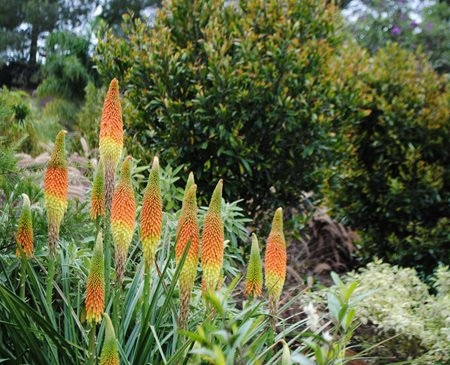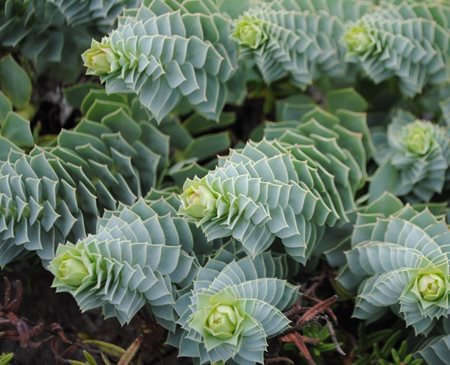Structural Plants: How to Use Architectural Plants in Your Garden
Unlock the power of structural plants and design a garden with year-round interest.When designing gardens, one of the first things I do is focus on key structural plants that will provide interest throughout the year while also serving a myriad of functions. Often called ‘statement plants’ or ‘architectural plants,’ structural plants have strong, unique, and striking shapes, whether from their form, foliage, flowers, or branching patterns. Structural plants, however, are more than just a conversation piece or something to delight the eye; their functional aspects are critical to the success of a garden.
For example, many structural plants are referred to as the ‘bones’ of a garden. Similar to the strength and support provided by the bones in our bodies, a garden’s ‘bones’ provide a year-round solid and sturdy framework for the entire garden, even in the bleakest days of winter.
Statement plants can also provide a subtle sense of order, which is especially important to many naturalistic gardens that can quickly appear a bit chaotic and out of control. In addition, structural plants can also create a sense of drama, anchor a garden, draw the eye upwards (making a smaller space appear larger), or help define traditional spaces.
On this page:STRUCTURAL PLANTS
SEA HOLLY (Eryngium spp.)
Plant type: Perennial
Zones: 4 to 9
Height: 2 to 3 feet tall, 1 to 2 feet wide
Structural Appeal: The seasonal structural from the long-lasting, thistle-like flowers are a favorite among gardeners and pollinators alike. Spiky bracts surround the center of each steely-blue flower, resulting in a stunning focal point moment or an impressive drift in the middle of the border.
TORCH LILY (Kniphofia spp.)
Plant type: Perennial
Zones: 5-9, sometimes colder, depending on variety
Height: 2 to 4 feet tall, 2 feet wide
Structural appeal: The structural torch-shaped flowers are a highlight in the early summer garden, lasting for weeks at a time. Further emphasize the flowers’ unique structure by surrounding them with contrasting shapes, such as the soft, grassy Carex divulsa or the cushion-shaped Euphorbia polychroma. Learn more about growing kniphofia.
WEEPING WHITE MULBERRY (Morus alba 'Pendula')
Plant type: Deciduous tree
Zones: 4 to 8
Height: 6 to 10 feet tall, 8 to 12 feet wide
Structural appeal: The unique umbrella shape of the weeping mulberry tree shines brightest in the winter months, resulting in a stunning focal point. Once every last leaf has dropped, the shape created by the gracefully weeping branches is a conversation piece in the garden like none other.
'RUBY FALLS' REDBUD (Cercis canadensis 'Ruby Falls')
Plant type: Deciduous tree
Zones: 5 to 9
Height: 8 to 10 feet tall, 3 to 4 feet wide
Structural appeal: Ideal for a small garden, patio, or container, the unusual cascading branches of ‘Ruby Falls’ resemble a graceful waterfall. Truly a four-season plant, the colorful foliage delights throughout spring, summer, and fall, with winter’s dormancy highlighting its unique structure. Learn more about growing redbud trees.
'SKY PENCIL' HOLLY (Ilex crenata 'Sky Pencil')
Plant type: Evergreen shrub
Zones: 6 to 8
Height: 6 to 10 feet tall, 1 to 3 feet wide
Structural appeal: Resembling an exclamation point in the garden, the robust and upright structure of the 'Sky Pencil' holly adds a surprising jolt of excitement to the garden bed. Use in a formal garden, to flank a pathway, or use as a single specimen to wake up a border. Learn more about growing holly shrubs.
MYRTLE SPURGE (Euphorbia myrsinites)
Plant type: Evergreen succulent
Zones: 5 to 8
Height: 6 inches high, spreading 2 to 3 feet wide
Structural appeal: Not all structural plants must be oversized; smaller groundcovers can be equally mesmerizing. The spirals of the evergreen twisting stems are just as eye-catching as the bright chartreuse spring flowers, making this a must-have for year-round interest. Learn more about how to grow euphobia plants.
FEATHER REED GRASS (Calamagrostis acutiflora 'Karl Foerster')
Plant type: Perennial ornamental grrass
Zones: 4 to 8
Height: 3 to 6 feet tall, 2 feet wide
Structural appeal: Beloved by garden designers everywhere (and the recipient of the 2001 Perennial Plant of the Year award), the towering, erect stems make a structural statement at the back of the border. This grass can be used alone as a focal point or massed together to create an impressive drift that gently sways with the slightest breeze.
YELLOWTWIG DOGWOOD (Cornus sericea 'Flaviramea')
Plant type: Deciduous shrub
Zones: 3 to 8
Height: 5 to 6 feet tall and wide
Structural appeal: The vibrant winter color and upright structure of this native dogwood make it an excellent candidate for a middle or back of the border focal point. The upright branching structure also helps to draw the eye upwards, adding visual motion and interest to the garden.
WEEPING NORWAY SPRUCE (Picea abies 'Pendula')
Plant type: Evergreen shrub
Zones: 2 to 8
Height: 8 to 20 feet tall, depending on how the plant is staked
Structural appeal: The dramatic serpentine form of the weeping Norway spruce resembles a waterfall when allowed to gently drape over a wall. Highlight its unique structure by using it as a breath-taking focal point for year-round interest.
DWARF GLOBE BLUE SPRUCE (Picea pungens 'Glauca Globosa')
Plant type: Evergreen shrub
Zones: 2 to 8
Height: 3 to 5 feet tall, 5 to 6 feet wide
Structural appeal: The natural globe shape of this compact shrub, combined with its powdery-blue foliage, makes this a low-maintenance, yet impactful, structure plant for the garden. Take advantage of this shrub’s visual density and unique form by using two to flank a pathway or place on either end of a perennial border.
CENTURY PLANT (Agave americana)
Plant type: Evergreen succulent
Zones: 8 to 11
Height: 3 to 6 feet tall, 6 to 10 feet wide
Structural appeal: No structural plant list would be complete without including the majestic Century Plant—it’s no wonder it won the Award of Garden Merit by the Royal Horticultural Society. Best suited for larger gardens, this succulent’s upright and oversized structure commands attention, making it an ideal focal point.

BOOK REBECCA AS YOUR NEXT GARDEN SPEAKER!
Fun, passionate, and knowledgeable, three words that describe Rebecca Sweet! See what discussion topics are available and watch a short video as Rebecca explains how her talks will inspire, entertain, and educate gardeners at all skill levels.
7 TIPS FOR USING STRUCTURE IN THE GARDEN

Wave Hill’s Flower Garden has a multitude of evergreen structures from the upright exclamation points to the mounding shrubs that anchor the perennial bed. Photo by: Rebecca Sweet.
- Provide the framework of the garden. Use evergreen structural plants to provide the framework or backbone of your garden. Whether defining a specific space or dividing the garden into specific rooms (i.e., kitchen garden, seating area, perennial bed,) evergreen shrubs can act as gateways, helping to transition from one space to another.
- Add year-round structure to a perennial bed. A framework of dependable, structural shrubs is at the heart of every successful border. These architectural plants anchor an overabundant perennial bed in the spring and summer and prevent a garden from going down with a whimper in the blistering hot days of August when many perennials have grown weary. Structural shrubs, whether evergreen or deciduous, also provide year-round interest in the quiet winter months.
- Combine contrasting form and shape. It’s true what they say: variety is the spice of life. If your garden has more predictability than pizzazz, the solution might be as straightforward as injecting it with a healthy dose of contrast. Contrast creates dynamic energy through the visual tension created by different elements (i.e., colors, textures, or forms). Incorporating a mix of structural shapes, such as mounding, vertical, or weeping, will keep your garden visually exciting throughout the year.
- Use restraint with strong forms. If a little’s good, a lot isn’t always better! The stronger the form, the more likely it is that it should be used as a single specimen to make a visual impact. Too many strong forms in one area can have the opposite effect, resulting in too much visual stimulus and chaos. To avoid this, use strong forms sparingly, surrounding them with plants with softer, mounding habits that won’t compete with their attention.
- Provide winter interest. Evergreen plants with substantial forms give a garden structure—and interest—in winter’s quiet months. Shrubs such as ‘Degroot’s Spire’ arborvitae (Thuja occidentalis) or ‘Compacta’ holly (Ilex glabra) not only have the strength and volume to stand up to oppressive mounds of snow but, when covered with a blanket of white, add visual interest in the garden. Deciduous shrubs also play an integral part, with winter highlighting those with extreme shapes to show off their usually hidden lines. Some structures, such as the twisting branches of Harry Lauder’s Walking Stick (Corylus avellana ‘Contorta’), the weeping branches of a European white birch (Betula pendula), or the dramatic shape of a weeping Norway spruce (Picea abies ‘Pendula’) often look their best in the dead of winter.
- Create a sense of whimsy. Memorable gardens contain memorable moments, sometimes as a result of a playful sense of humor. Create a sense of whimsy using plants with unique structures (i.e., the weeping waterfall effect of a Blue Atlas cedar (Cedrus atlantica ‘Glauca Pendula’), or spiky, twisty branches of the monkey puzzle tree (Araucaria araucana)—which is sure to be the talk of the neighborhood!
- Choose double-duty structure whenever possible. To get the most bang for your buck, try incorporating shrubs with more than one unique feature. For example, the pyramidal form of evergreen Soft Serve® Gold false cypress (Chamaecyparis pisifera) provides a unique structure to the garden, but also offers an unusual golden color.
RELATED:
More from Rebecca Sweet
Foliage Over Flowers
Landscape Design Ideas & Inspiration












